Virtual Visits: A case study on the use and benefits of clinician-initiated virtual visits
Virtual visit technologies enable two-way, digital communication between healthcare clinicians and their patients, allowing a clinician to conduct a visit with their patient virtually through secure asynchronous messaging, and/or synchronous* audio or video conferencing1. Virtual visits have shown promising results in supporting patient-centered health care1, providing convenient access to care that meets patient needs, especially for those who experience barriers to accessing care, such as those in remote geographic locations, those with mobility issues or busy lifestyles that make it challenging to access the care they need when they need it.
Key takeaways
Virtual visits can be integrated into primary care workflows as a complement to existing models of care, providing primary care clinicians another option to interact with, follow up with and monitor patients, promoting a more patient-centric approach to health care.
To support primary care across Waterloo Wellington, in March 2018, the eHealth Centre of Excellence in collaboration with the Ontario Telemedicine Network initiated the deployment of a virtual care solution. Primary care engagement in the development of the solution illustrated the need to facilitate provider-initiated virtual visits, to further optimize the use and benefits of this solution for patient concerns that may not require an in-person visit with a primary care clinician.

I often use a virtual visit to follow-up with a patient regarding test results. It only takes me a few minutes, and helps to keep my schedule open to see more acute or complex issues. Virtual care really helps with patient care, satisfaction and access, without a lot of work on my part. Day by day it is becoming a larger part of my practice.
Dr. Anil Maheshwari
Grandview Medical Centre
Virtual visits enable primary care clinicians to provide care for a variety of appointment types that are suitable for virtual care. Figure 1 below illustrates the appointment reasons for which a clinician initiated a virtual visit with their patient.

Clinician-initiated virtual visits were most beneficial for following up on a patient’s test results, existing conditions, previous appointment and/or discussing medications. The results highlight the ease of using virtual visits for a wide variety of suitable appointment types and efficiently communicating with patients who may not require an in-person visit.
Although currently listed as less than one percent (1%) of visits, post discharge follow-up is one of the primary care priority indicators for quality2. Virtual visits provided primary care clinicians with another option to conveniently reach patients and facilitate effective transitions through different levels of care as part of the patient’s circle of care.
Understandably, hospital discharges are less frequent than other patient care needs illustrating the low proportion of virtual visits for this purpose, as compared to other reasons.
Figure 2. Clinician experience (n=21)
Patients who had received virtual visit requests from their primary care clinician also indicated positive feedback, noting the time saved, convenience and the satisfaction with the care received.
Figure 3. Patient experience with virtual visits initiated by primary care clinician (N=116)
- McGrail, K. M., Ahuja, M. A., & Leaver, C. A. (2017). Virtual Visits and Patient-Centered Care: Results of a Patient Survey and Observational Study. Journal of Medical Internet Research, 19(5), e177. https://doi.org/10.2196/jmir.7374
- Health Quality Ontario. (2019) Indicator Technical Specifications 2019/20.
Interested in learning more?
Interested in partnering with us or learning more about
what we can offer you? Please reach out here.
Get the latest resources and insights
-

Patient experience with eReferral in Ontario Health North Region
Patients who are emailed appointment information and reminders report an improved healthcare experience and prefer…
-

eConsult and eReferral supporting Mental Health & Addictions (MHA) Care
Mental illness is experienced by one in five Canadians in any given year1. Wait times…
-

Webinar on leveraging AI scribes for your ideal practice (part 1)
Sharing some tips, tricks, and key takeaways from our Ideal Primary Care Practice Model webinar,…
-

Specialists’ satisfaction with eReferral in OH-West
Specialists and office staff are accepting eReferrals in place of faxed referrals. Findings are based…